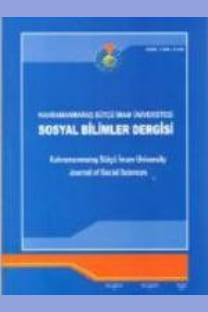OECD Ülkelerinde Ar-Ge Teşvikleri ve İnovasyon İlişkisi Üzerine Ampirik Bir İnceleme
Bilgi ekonomisi çağında Ar-Ge faaliyetleri yapmak bir ihtiyaçtan ziyade zorunluluktur. İnovasyonun ve teknolojik gelişmenin ekonomik büyümenin merkezine taşınmasıyla birlikte Ar-Ge göstergeleri bir iktisadi gelişmişlik ölçütü olarak kullanılmaktadır. Firmaların ve ülke ekonomilerinin güçlü olması yeniliği ne kadar iyi ve ne kadar kısa zamanda yakaladıkları ile orantılıdır. Günümüz dünya ekonomisinde önemi her geçen gün artan yenilik faaliyetlerini teşvik etmek amacıyla devlet, özel sektöre doğrudan ve dolaylı yolla destek sağlamaktadır. Bu çalışmanın amacı, söz konusu teşviklerin ulusal bazda geliştirilen inovasyon üzerindeki etkisini OECD ülkeleri için 2016 yılı verilerini kullanarak yatay-kesit analiz yöntemi ile ölçmektir. Çalışmadan elde edilen ampirik sonuçlara göre, OECD ülkelerinde Ar-Ge teşviklerinin inovasyon üzerinde istatistiksel olarak anlamlı bir etkiye sahip olmadığı bulgusuna ulaşılmıştır.
Anahtar Kelimeler:
Ar-Ge Teşvikleri, İnovasyon, OECD
An Empirical Study on R & D Incentives and Innovation Relation in OECD Countries
R&D activities in the age of knowledge economy are a necessity rather than a need. With the transfer of innovation and technological development to the center of economic growth, R&D indicators are used as a measure. The strengths of firms and economies are proportional to how well and how quickly they catch up with innovation. The government provides direct and indirect support to the private sector in order to promote innovation activities that are becoming increasingly important in today's World economy. The purpose of this study is to measure the impact of these incentives on innovation by using the cross-sectional analysis method for 2016 data of OECD countries. According to the empirical results obtained from the study, it was found that R&D incentives in OECD countries did not have a statistically significant effect on innovation.
Keywords:
R&D Incentives, Innovation, OECD,
___
- Ağır, H. ve Kar, M. (2010), “Türkiye’de Elektrik Tüketimi ve Ekonomik Gelişmişlik Düzeyi İlişkisi: Yatay Kesit Analizi”, Sosyoekonomi, Özel Sayı.
- Akçomak, İ.S. ve Kalaycı, E. (2016), “Ar-Ge ve Yeniliğin Ölçümü ve Ar-Ge ve Yenilik Anketi Verilerinin Araştırmada Kullanılması”, TEKPOL Working Paper Series, STPS-WP-16/03, http://stps.metu.edu.tr/sites /stps.metu.edu.tr/files/WP%2016%3A03.pdf (20.02.2019).
- Apak, S. -Sarıdoğan, E.- Uçak, A.(2008), “Macroeconomic Determinants of Innovation”, International Conference Patent and Innovation, Tokyo, Japan, December 19-20, Applied Econometric Association.
- Bilbao-Osorıo,B.ve Rodriguez-PoseA.(2004),“From R&D to Innovation and Economic Growth in the EU”, Growth and Change, Vol. 35 No. 4, pp. 434-455.
- Bernanke, B. S. (2011), “Promoting Researchand Development: The Government’s Role”, New Building Blocks for Jobs and Economic Growth Conferance, Georgtown University, May 16.
- Brander, J.A.-Egan, E.-Hellmann, T.F. (2008),“Government sponsored versus private venture capital: Canadian evidence” NBER Working Paper (No. w14029).
- Branstetter, L. and Sakakibara, M. (1998), “Japanese research consortia: A microeconometric analysis of industrial policy”, J. Ind. Econ. 46 (2), pp. 207–233.
- Bronzini, R. and Piselli, P. (2016), “Theimpact of R&D subsidies on firminnovation”,ResearchPolicy, 45, pp. 442–457.
- Busom, I., (2000),“An Empirical Evaluation of TheEffects of R&D Subsidies”, Economics of Innovationand New Technology, 9:2, pp. 111-148.
- Choia, J. and Lee, J. (2017), “Repairing the R&D market failure: Public R&D subsidy and the composition of private R&D”, Researh Policy, 46, pp. 1465–1478.
- Clausen, T.H. (2009), “Do subsidies have positive impacts on R&D and innovation activities at the firm level?”, Structural Change and Economic Dynamics, 20, pp. 239–253.
- Czarnitzki, D. Hanel, P.-Rosa, J.M. (2011), “Evaluating the Impact of R&D Tax Credits on Innovation: a Microeconometric Study on Canadian Firms”, Research Policy, 40, 217-229
- Guo, D.-Guo,Y.-Jiang,K. (2016), “Government-subsidized R&D and firm innovation: Evidence from China”, Research Policy, No:45, pp. 1129-1144 Dünya Bankası, https://databank.worldbank.org (15.02.2019)
- Erden, Y. (2015), “Kamu Ar-Ge Destekleri ve Yenilik Modelleri: Kamu Ar-Ge Politikalarının Meşrulaştırılması İçin Hangi Yenilik Modeli Seçilmeli?”, Ekonomi Bilimleri Dergisi, 1 (2), ss. 25-39.
- Falk, M. (2004), “What Drives Business R&D Intensity Across OECD Countries?”, Austrian Institute of Economic Research WIFO, No. 236.
- Furman, J.L.- Porter, M.E.- Stern, S. (2002), “The Determinants of National Innovative Capacity”, Research Policy, 31, pp. 899-933.
- Griliches, Z. and Regev, H. (1998), “An econometric evaluation of high-techpolicy in Israel”, Paper presented at ATP-conference in Washington, DC.
- İncekara, A.- Demez, S.- Akyol, M. (2014), “Ar-Ge Harcamalarına Yapılan Teşviklerin Etkinliği: Türkiye BRICS Ülkeleri Karşılaştırmalı Analiz”, Journal of Economıc Policy Researches, Cilt:1, Sayı: 2, ss. 1-30.
- Jaumotte, F. ve Pain, N. (2005), “An Overview of Public Policies to Support Innovation”, OECD Economics Department Working Papers, No: 456, OECD Publishing.
- Klette, T.J. and Moen, J. (1999), “From growth theory to technology policy: coordination problems in theory and practice”, Nord. J. Polit. Econ. 25, pp. 53–74.
- MÜSİAD (2012), Küresel Rekabet İçin Ar-Ge ve İnovasyon, Müsiad Araştırma Raporları:76, İstanbul.
- OECD, (2019), Main Science and Technology Indicators, https://stats.oecd.org/Index.aspx?DataSetCode=MSTI_PUB, 13.02.2019.
- Porter, M.E. and Stern, S. (2000), “Measuring the ‘Ideas’ Production Function: Evidence from International Patent Output”, NBER Working Paper, No: 7891. Sakarya, A.O. (2009), “Variables Affecting Innovation-Related Competitiveness in Turkey”, Innovation Policies, Business Creation and Economic Development, (Ed.: Neslihan Aydoğan), Springer Science and Business Media: New York, pp. 63-84.
- Studenmund, A.H. (1992). Using Eonometrics: A Practical Guide. Second Edition, New York: Harper Collins Publishers.
- Tüylüoğlu, Ş. ve Saraç, Ş. (2012),“Gelişmiş ve Gelişmekte Olan Ülkelerde İnovasyonun Belirleyicileri: Ampirik bir Analiz”, Eskişehir Osmangazi Üniversitesi, İ.İ.B.F., Dergisi, 7(1), ss. 39-74.
- Wooldridge, J. M. (2001), Econometric Analysis of Cross Section and Panel Data. The MIT Press, Cambridge, London.
- Yang, C.H.-Huang, C.H.-Hou, T.C.T. (2012), “Tax incentives and R&D activity: Firm-level evidence from Taiwan”, ResearchPolicy, 41, pp. 1578–1588.
- ISSN: 1304-8120
- Yayın Aralığı: Yılda 3 Sayı
- Başlangıç: 2004
- Yayıncı: Kahramanmaraş Sütçü İmam Universitesi
Sayıdaki Diğer Makaleler
İnsani Müdahalelerde Medyanın Rolü: Libya ve Bahreyn Karşılaştırması
Üniversiteli Sporcuların Psikolojik Dayanıklılık Düzeylerinin İncelenmesi
Türkiye'de Yerel Yönetimlerin Yaşanabilir Kent Oluşturma Politikaları
Ortaokul Türkçe Ders Kitaplarında Çokluk Kavramı-Anlamsal Çokluk
Erkan Arslan, Fatih GÜRSES, Ali ÇİÇEK
Alaeddin Özdenören’de Şiir ve Felsefe
Zeynep HATUNOĞLU, Haluk SATIR, Feyzi YAŞAR
Demokrat Parti Dönemi Maraş Basını
93 Harbi’nde Hindistan Müslümanlarının Osmanlı Devleti’ne Yardımları
